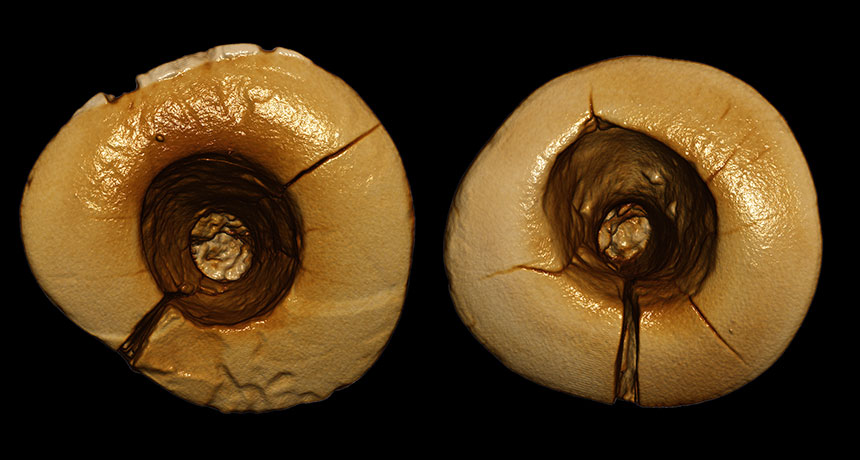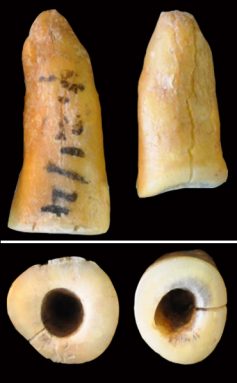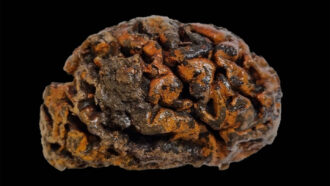biological anthropology (also bioanthropology) The study of human origins (and culture) that focuses on the evolution of hominids and other primates based on their biology and how it might explain how their bodies adapted to their environment. Scientists who work in this field are known as biological anthropologists.
bitumen A natural type of especially heavy, dense petroleum. This type of heavy crude oil must be diluted before it can flow through pipelines.
cavity (in dentistry) A tiny hole in a tooth that develops over time. Cavities are more likely to happen when a person eats a lot of sugar or does not brush and floss regularly. Dentists refer to these as caries.
chemical A substance formed from two or more atoms that unite (bond) in a fixed proportion and structure. For example, water is a chemical made when two hydrogen atoms bond to one oxygen atom. Its chemical formula is H2O. Chemical can also be used as an adjective to describe properties of materials that are the result of various reactions between different compounds.
decay The process (also called “rotting”) by which a dead plant or animal gradually breaks down as it is consumed by bacteria and other microbes
fiber Something whose shape resembles a thread or filament of some kind. (in nutrition) Components of many fibrous plant-based foods. These so-called non-digestible fibers tend to come from cellulose, lignin, and pectin — all plant constituents that resist breakdown by the body’s digestive enzymes.
genus (plural: genera) A group of closely related species. For example, the genus Canis — which is Latin for “dog” — includes all domestic breeds of dog and their closest wild relatives, including wolves, coyotes, jackals and dingoes.
Homo A genus of species that includes modern humans (Homo sapiens). All had large brains and used tools. This genus is believed to have first evolved in Africa and over time its members continued to evolve and radiate throughout the rest of the world.
hunter-gatherer A cultural group that feeds itself through hunting, fishing and gathering wild produce (such as nuts, seeds, fruits, leaves, roots and other edible plant parts). They can be somewhat nomadic and do not rely on agriculture for their food.
infection A disease that can spread from one organism to another. It’s usually caused by some sort of germ.
intervention A planned effort to prevent or treat a disease or other condition relating to health or well-being.
journal (in science) A publication in which scientists share their research findings with the public. Some journals publish papers from all fields of science, technology, engineering and math, while others are specific to a single subject.
microscopic An adjective for things too small to be seen by the unaided eye. It takes a microscope to view objects this small, such as bacteria or other one-celled organisms.
nut (in biology) The edible seed of a plant, which is usually encased in a hard protective shell.
paleoanthropologist A scientist who studies ancient humans and hominid biology and the behavior and how hominids evolved. This field is based on the analysis of fossils, remnants, artifacts or markings created or used by these individuals.
physical anthropology The type of anthropology, or study of humankind, that deals with how humans have gradually changed over time. It includes how their look or structures might have varied.
starch A soft white chemical made by all green plants. It’s a relatively long molecule made from linking together a lot of smaller, identical building blocks — all of them glucose, a simple sugar.
Stone Age A prehistoric period when weapons and tools were made of stone or of materials such as bone, wood or horn. This period lasted millions of years and came to an end around 10,000 to 12,000 years ago.
tissue Any of the distinct types of material, comprised of cells, which make up animals, plants or fungi. Cells within a tissue work as a unit to perform a particular function in living organisms. Different organs of the human body, for instance, often are made from many different types of tissues.
tool An object that a person or other animal makes or obtains and then uses to carry out some purpose such as reaching food, defending itself or grooming.









